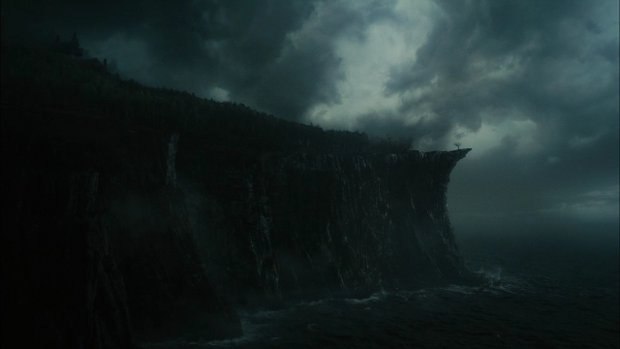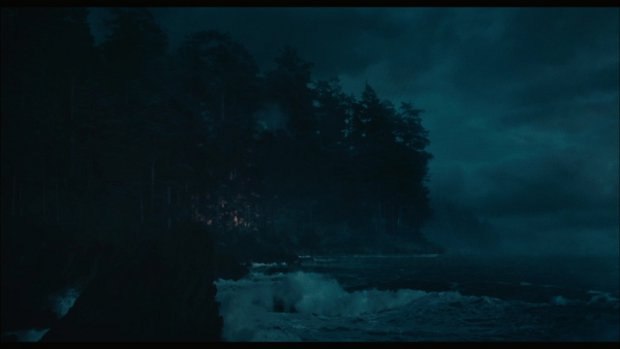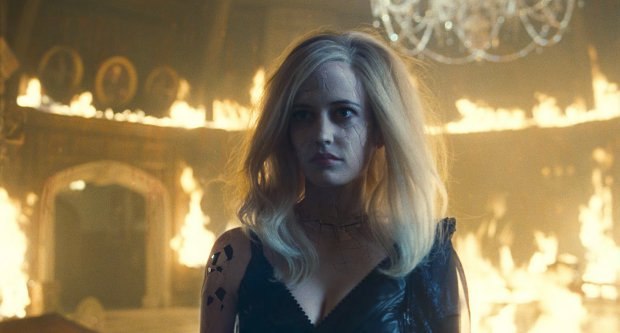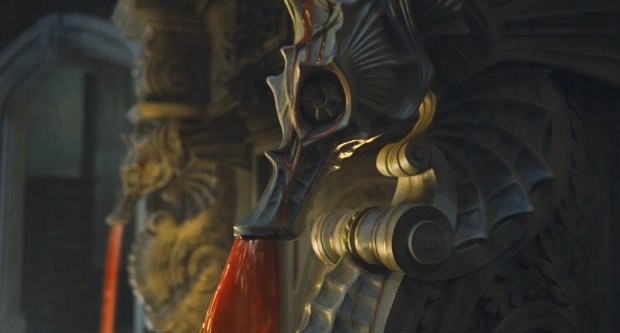Learn how MPC bit off a 340 shot piece of Tim Burton’s new gothic horror-comedy film.
Tim Burton’s latest film, Dark Shadows, takes moviegoers on a 220 year journey from the docks of Liverpool to the quaint fishing town of Collinsport, Maine, as we watch first-hand the carnage of a two century old battle of jilted and cursed lovers.
Splitting the work between London and Vancouver facilities, visual effects house MPC handled 340 shots, led by vfx supervisors Arundi Asregadoo and Erik Nordby.
Nordby’s Vancouver team handled completion of just over 90 shots. Their efforts focused on two sequences set in and around a 200 foot high sea-side cliff, known as “Widow’s Hill.” Much of the pivotal action takes place here between Barnabas and his true love from each respective time period. Two times, once in each time setting, people leap off the cliff onto the jagged rocks below, though their tragic fates are forever altered by the vampire’s curse.
The cliff itself was comprised of seven large slices of rock-face, all built at different resolutions depending on how they were used in the movie. Much of the action takes place on the cliff’s edge, which needed to match a set piece built during production. This is where the first and highest LOD slice of the cliff was done. Several additional promontories were then built along the coastline, used mainly in large establishing shots of the area.
A combination approach was taken with the various cliff shots, splitting the tasks between DMP/Env and traditional assets. The rough shape of the cliff was built, with some portions sculpted in Z-brush for added details. The shots were lit to give as much of a natural feeling to the terrain as possible. A bespoke set of Env textures was projected onto the slices, with the two then being married for the final composition.
Resting above the cliff was a pine forest as well as the Collins family manor. The forest was built by seeding individual trees using VUE software and then painting over the top. This allowed natural variation and parallax on the moving shots.
The Vancouver studio was also tasked with creating the large establishing shots of Liverpool that open up the film. With the exception of the family boarding a walkway on a green screen set, the final shot were done entirely inn CG. Once again, the Providence Boat was re-purposed and re-textured, forming the focus of the shot. An entire CG dock was built using digital props and buildings cobbled from various other shows. Finally basic CG water, fog and mist were built onto cards to set the scene.
MPC London handled a number of detailed shots as well, including the other-worldly showdown between Barnabas Collins and his vengeful foe and ex-lover, the witch Angelique. The action takes place in the grand foyer of Collinwood manor and involved a myriad of elements, including wooden statues coming to life, Angelique’s gradually cracking skin, a vengeful ghost, and a teen werewolf.
The team also augmented the scene with various destruction elements, including bleeding walls, floors cracking and flowers dying.
Angelique’s transformation into a cracking “porcelain doll” was an especially challenging sequence. The team worked on over 115 shots showing her gradual calcification and break down, as well as a shot where she pulls a beating heart from her chest. The effect involved an intensive rigging study as well as a large team of roto-animators, who painstakingly match-animated to all Angelique’s shots. A team of technical animators further finessed the tracks, replacing the cracked model of Angelique into the shots. 7 different models were constructed during the building phase, each according to how the cracks increased and deepened throughout the scene. The lighting TD team handled both the cracked and clean or “un-cracked” versions for each shot to make the manipulation in compositing much easier. The compositing team also did a significant amount of 2D tracking on some shots with less movement, and made the finishing touches to each shot using two lighting passes and their own 2D tools.
Carolyn Stoddard, the “troubled teen” daughter of family matriarch Elizabeth Collins Stoddard, who morphs into a werewolf for the film’s climactic showdown, was another great challenge for the team. MPC has taken on CG werewolves before (Wolfman, Harry Potter, X-Men: First Class). Though their pipeline was prepared for the work, they had not previously tackled such highly stylized werewolf designs. The art department was able to create something very close to director Tim Burton’s vision after a fairly involved 3D groom and lookdev process. The final render was completed with animated wolf legs in shots depicting her showdown attack on Angelique.
MPC’s DMP, FX and animation departments worked closely on the Grand Foyer sequence, bringing various wooden statues to life. As Angelique casts her spells around the house, we see her bring to life a number of wooden statues, including a serpent and caryatids. Elizabeth, brandishing a shotgun, blows the heads off many of the animated creatures. The statues were built with considerable flexibility in their rigs so that they could perform numerous eerie and often violent movements. MPC Animation Supervisor Peta Bayley had her team focus on the statues as a single “beat” of the action and the FX team added “breaking away” FX as the statues tore away from the wall. The DMP team played an important role in creating a sense of cascading levels of blood and destruction unfolding in the background. The start of the scene involves a segment with hero shots involving action elements used to sell the idea of blood seeping from statues and cracks. MPC’s 3D DMP department was able to sustain these elements across 200 shots without distracting from the foreground action. And some action it was indeed.
--
Dan Sarto is publisher and editor-in-chief of Animation World Network.
Dan Sarto is Publisher and Editor-in-Chief of Animation World Network.















